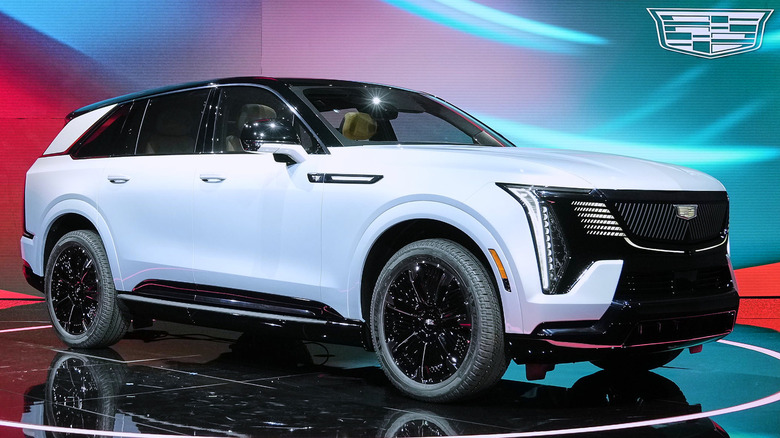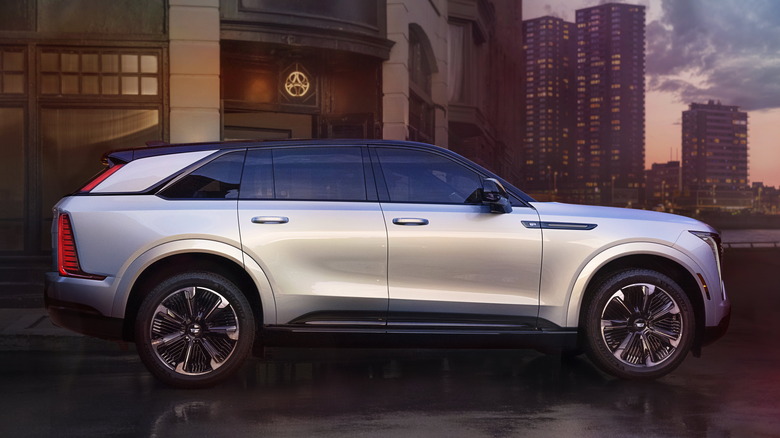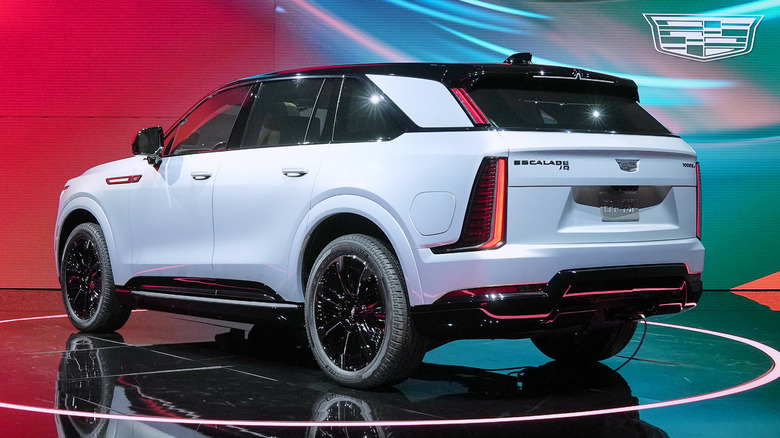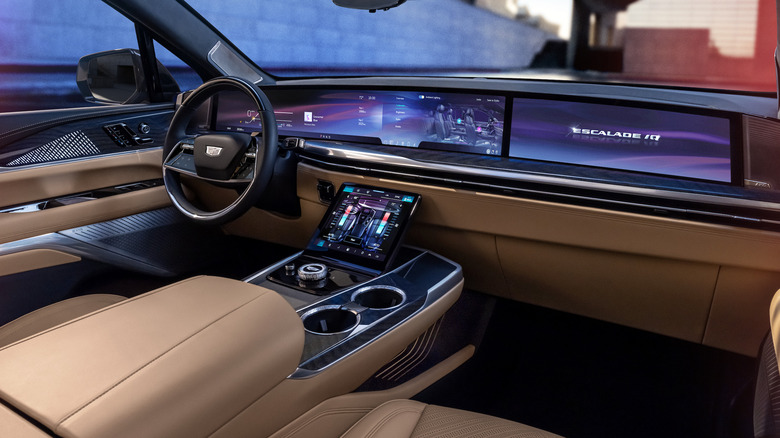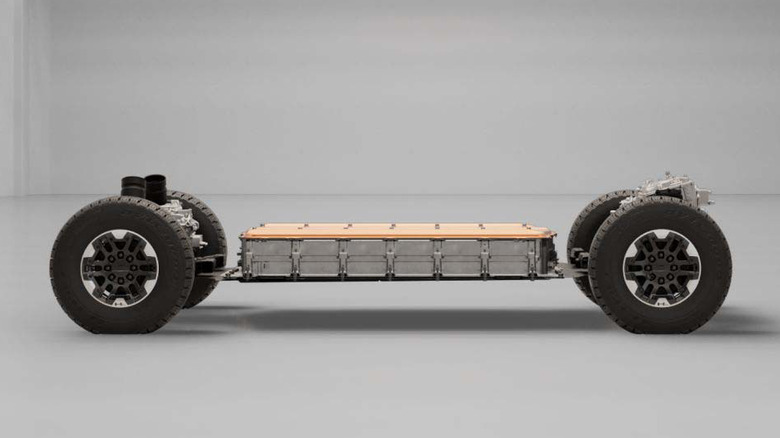The Cadillac Escalade IQ Comes At A Huge Cost
This week, Cadillac unveiled its newest Ultium-based super-SUV, the Cadillac Escalade IQ EV. No mere run-of-the-mill Escalade with batteries in the trunk, it's a new design entirely, at least on the outside. On the inside, it uses an increasingly familiar 800-volt charging architecture, two electric motors capable of 680 combined horsepower (with the ability to boost itself to 750 horsepower), and of course all the luxuriousness that goes with a $130,000 Caddy.
Not for nothing, the IQ will also have the ability to crab-walk, as in drive diagonally thanks to its four-wheel steering, like the Hummer EV. In consideration of the target audience — which probably prefers to eat crustaceans rather than ape them — the automaker eschews the arthropod-based name and instead calls it "Cadillac Arrival Mode."
There is nothing "wrong" per se with the IQ. The gas-powered Escalade is Cadillac's bread and butter and the EV-version will likely sell rather well and give Cadillac buyers an opportunity to stunt on other Cadillac buyers. It's hard to find purely technological faults in a vehicle that will likely weigh more than a newborn humpback whale, and yet still possess the ability to launch itself to highway speed down an on-ramp in less than five seconds and get upwards of 450 miles of range.
But, the IQ comes at a strange time in EV history, and one that could prove costly to GM's plans for an Ultium-based future.
It's crowded at the top
As of now, there are several high-performance luxury EVs on the market, many of them SUVs. The subject of this week's headlines, the Escalade IQ, finds itself sharing space with the Hummer EV, the Tesla Model X, BMW iX, the Rivian R1S, the Lucid Air, and the menagerie of different similarly-named SUVs from Mercedes. If you count flagship EV trucks and sedans, the number of available models grows significantly. That's all well and good. But market saturation might be too lenient of a term. In addition to cannonballing into an already crowded pool of EVs that all cost around six-figures, the electrified version of the Escalade was mostly a forgone conclusion. As great as the specifications are, it's one of the least surprising vehicles in recent memory.
Let's go to the opposite end of the somewhat narrow EV spectrum. When you consider entry level cars, you come up startlingly close to completely empty handed, with the undead Chevy Bolt, hopelessly outdated Nissan Leaf, and a smattering of vehicles like the Chevy Equinox EV, and Fisker PEAR that have yet to see the light of the dealership showroom. Only the Tesla Model 3 and the offerings from Hyundai and Kia escape the entry-level EV wasteland. Although, to many, $40,240 for a bone-stock Tesla Model 3, or $39,550 for a Kia Niro EV hardly constitutes "entry level." All told, the Escalade IQ probably isn't what the market needs right now.
Everybody out
The IQ is emblematic of another problem that GM hasn't done much about, the Ultium platform. The "electric skateboard" architecture was initially touted for its versatility, modularity, and ability to be scaled to any size. So far, GM has made increasingly larger SUVs and trucks, hardly demonstrating anything other than the fact that anything Ultium-based, for the time being, is both huge and expensive. It seems like a wasted opportunity first and foremost, and ultimately lazy.
Sure, an ultra-fast, ultra-exclusive SUV that can fly, do your taxes, and make your crops grow faster is cool and sure to get people excited about the technology, but it likely won't ultimately help sell cars. Which really should be GM's goal after all. General Motors is not a technology company: it sells cars.
GM's EV-centric slogan is "Everybody In." A six-figure EV like the Hummer EV, IQ, and upcoming Sierra Denali are hardly playing to the slogan's inclusive tune. The Chevy Bolt and EV Equinox are more harmonious to GM's planned electric future. Cadillac can barely sell the Lyriq and until the Equinox finally rolls off the line, and GM decides what to do with the Bolt, Ultium technology is decidedly limited in its scope. That is, unless you're willing to shell out for a Cadillac.
Inefficiency in the name of efficiency
Perhaps most importantly, there's the material cost of an IQ. According to Cadillac, the IQ has a 24-module 200-plus kilowatt hour battery. For comparison, the pickup version of the GMC Hummer and the highest-specification Silverado RST EV also use a 24-module battery. The SUV version of the Hummer uses a 20-module battery. The smaller Cadillac Lyriq uses a 12-module 100 kilowatt-hour battery architecture. Through this, GM has only proved that it can only make giant SUVs/trucks and exactly one crossover with Ultium technology.
If Ford's battery production problems with the F-150 Lightning have taught us anything about EV battery sourcing, it isn't always a straightforward process. General Motors (probably) isn't in danger of running out of batteries, but the resources used to make that 24-module 200 kilowatt hour battery could arguably be much better applied in the production of two or even three smaller EVs. And smaller EVs are really what the market — and the environment –needs right now.
The Ultium ultimatum
The Cadillac Escalade IQ is a costly vehicle on all fronts. At $130,000 and upwards, it's expensive to the customer. In the already crowded market of super-EVs, the IQ even sits towards the top when it comes to sheer size. And from a strictly material cost, for every giant Ultium pack that GM makes for the IQ, that effectively takes away from whatever smaller battery pack GM could make concurrently or in the future.
The IQ is fast, reasonably good looking, incredibly capable, and possesses a nearly unheard of range among big EVs. Yet it's tough to escape the conclusion that the right vehicle for Cadillac is also exactly the wrong vehicle for today. Whether or not GM or other automakers are aware of this or not is anyone's guess. But GM may find out soon that the Escalade IQ was a misstep when another automaker beats them to punch in making a smaller, less expensive, more efficient EV, something that the Ultium platform has so far failed to deliver.
